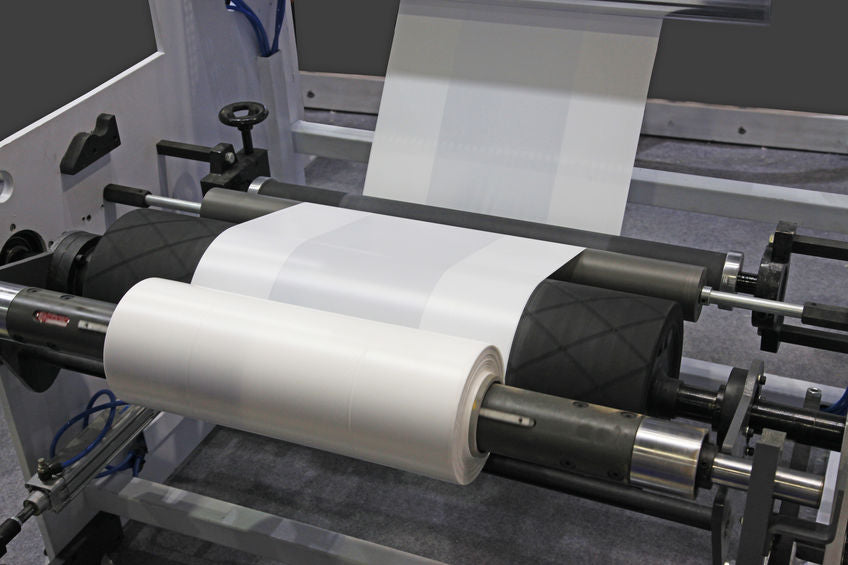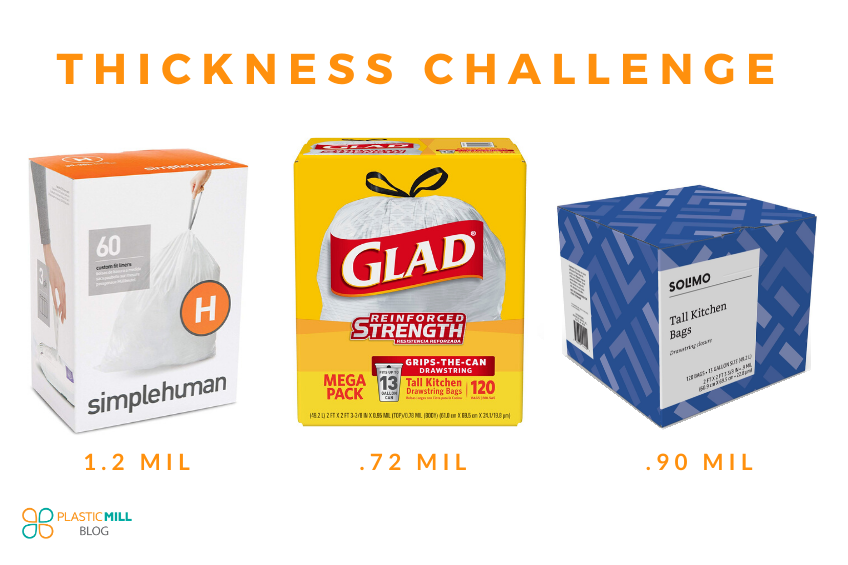Understanding the Thickness of Garbage Bags
Posted by Vivian McNeil on
There are many thicknesses of garbage bags to choose from, but how do you know which is best for your needs? Many people buy trash bags without considering their garbage bag mil thickness, leading to frustration when bags rip or slip inside the bin. Then you have the homeowners who have been buying a box of black garbage bags just because that’s what their mother did. Meanwhile, the bag is constantly slipping when a heavy piece of trash finds a home in the receptacle. At that point, whichever party in the kitchen feels responsible enough for the kitchen garbage can, will try and locate the two sides of the bag and attempt to bring it over the bin lip. They will then hope and pray that the lid will hold it in place and prevent it from slipping in again. Of course, that’s all until the next resident of the home needs to scrape their plate off from supper and there it goes again, into the trash bin. Finally, the household trash bag is full and lifted out of the bin, all the trash sinks to the bottom which creates a significant air cavity on top. This will quickly fill up your outdoor trash can days before the local sanitation service picks it up.

Common frustrations like these can be avoided if both residential and commercial garbage bag consumers understand garbage bag types. By comprehending trash bag capacity and thickness you will be able to get the right type of trash bag the first time, and not get stuck with hundreds of bags that don’t fit your business or household needs.
What material is used to create a plastic garbage bag?
Before getting into the types of thickness and perhaps density, we need to first get a clear picture of how plastic trash bags are made. The commonality between most garbage bags is that they are made from polyethylene resin. The polyethylene film is made of extruding molten resins through a dye to create a bubble. Once this step is complete, the film will then be flattened and passed through many rollers until it cools down and is ready to be cut and boxed for distribution. The main ingredient, resin can come in two forms, processed resin and virgin resin. It’s possible that a thinner bag made of virgin resin might be able to outperform a thicker bag made of processed resin. In order to gain equal strength between both bag types, a significant amount of processed resin will be necessary, more than those bags made from virgin resin. It’s quite clear, virgin resin outperforms processed resin.

How is Garbage Bag Thickness Mil Measured?
There are many ways to measure a garbage bag’s thickness, but the most common way is done by a micrometer. There are both manual and electric micrometers which are used to measure the bag’s thickness in mil. A mil is defined by Dictionary.com as follows; “A unit of length equal to 0.001 of one inch (0.0254 mm), used in measuring the diameter of wires”. It’s a very small metric but can make the biggest difference when choosing a garbage bag. When the manufacturer measures the bag’s thickness, they take a micrometer and place the plastic between the two external jaws. The micrometer will then compute the measurement in mils.
When choosing a garbage bag thickness mil, contractors need to consider durability. Contractors that are transporting trash that’s heavy and possibly sharp, will want to shop for a high-density thick trash bag. Many contractor garbage bags can be thin and tear when handling heavy duty trash. For a household, fall cleanup, and other light trash, the thickness of garbage bags might not be that important, and a .82 mil bag should suffice. If your tall kitchen trash bag is not holding up, try looking for a higher mil trash bag. Once you find the right bag that works for you, stock up and buy a big box of these trash bags. People tend to take a liking to the brand and stick with a specific garbage bag which works for them and their family. Commercial facilities will pretty much do the same and be consistent with the trash bags they choose to use.
The Trash Bag Thickness Guide
So what is the thickest garbage bag available? In order to dumb down this concept, we will provide a description for each trash bag thickness followed by a comprehensive table which you can easily identify the specific garbage bag you’re looking for. It may come in handy for a homeowner or facility manager who is looking for garbage bags which match the trash that’s being handled.
Trash Bag Thickness Chart
| Trash Type | Density | Thickness Range | Mil or Microns? | Can Type |
|---|---|---|---|---|
| Light | Low | .30 - .49 | Mil | For Small Cans |
| Heavy Duty | Low | .75 - 1.2 | Mil | For Midsize Cans |
| Super Heavy Duty | Low | 1.3 - 2.0 | Mil | For Larger Cans |
High Density vs Low Density Trash Bags
There are two main material types which are offered to consumers. High density trash bags will have a thin and flimsy feel while low density garbage bags will feel smoother and softer. More cost-effective trash liners will often come in a high-density plastic. This is important to notate, because most laymen think that high density is stronger than low density, and now you know that’s not the case. When looking for a durable trash bag that’s strong, resistant to puncturing and tearing you want to go with low density garbage bags. Always remember to stay low when looking for heavy duty garbage bags.
Trash Bag Thickness in Mil and Microns
Once you know what type of density bag you're looking for, there will be two metrics to look out for, mil and microns. As explained above, a mil is 0.001 of one inch while a micron is a micrometer or better known to those in the United States as 0.00004 inches. The micron is a significantly smaller metric than that of the mil. Therefore, if one is looking for a thick, puncture resistant trash bag, they should make sure to look for a thickness in mil while if one is looking for a trash liner to collect shredding, a thickness in microns would suffice.

Standard Trash Bag Thickness
Since many homeowners are purchasing tall kitchen trash bags, we will choose three trash bags on Amazon that had at least a 4.5 star rating, with 5,000+ reviews (the fact that there were 5,000+ reviews shows us that a good portion of the homes in the United States use these bags). The simplehuman® Code H trash bag, holds 30 to 35 liters of trash and claims to be thick. With its 11,000+ reviews we could not locate the thickness measurement but found it on Home Depot, measuring at 1.2 mil. The next trash bag, with 6000+ reviews was the Glad tall kitchen drawstring trash bags. It holds 13 gallons of kitchen trash and has a .72 mil thickness. The final garbage bag was Amazon's own brand, with 5000+ reviews, the Solimo tall kitchen drawstring trash bags. It holds 13 gallons of kitchen trash and has a .9 mil thickness. There are many high quality brands which offer the same codes, thickness, and low density as simplehuman® for less.

Upon review of the above three bags we can determine that the standard garbage bag thickness for tall kitchen trash bags ranges from .72 to 1.2 mil. Anything lower might be subject to puncturing, tearing, and leaving you with a big mess. Keep in mind that even though the trash bag made it from the kitchen to the outdoor trash can, it may not make it from the trash receptacle to the garbage truck. Did you ever see how those strong garbage men yank out those bags? They might take the bag but leave the trash behind.
White vs. Black Garbage Bags
There are claims that the chemical make-up of white garbage bags is from virgin resin and stronger while chemical make-up of black garbage bags may come from recycled plastic. This plastic is broken down and remade into resin type of plastic which can be reproduced into black trash bags. The deep black color gives more flexibility of placing other elements into the compound. Another advantage of using white garbage bags is that they are food grade and prevent food contamination. Black trash bags, on the other hand are not food grade and are susceptible to contamination.
Final Words
There are many specifications in the trash bag or trash liner you choose. It’s important for the consumer to first identify what content will be placed in the trash bag. When disposing lighter items, thickness in density might not make that much of a difference. On the other hand, a kitchen trash receptacle might contain sharp items like plastic forks, aluminum pans, and other puncturable trash. You then want to make sure that your bag thickness is low density, and measures somewhere between .72 and 1.2 mil. If you wish to not get so technical and don’t care for microns or mils, it will be trial and error. Just make sure that when you are trying out a new trash bag not to purchase such a big box. You don’t want to get stuck with a big box of high-density trash bags that puncture and tear easily. What you are looking for is a garbage bag that is not trash.
